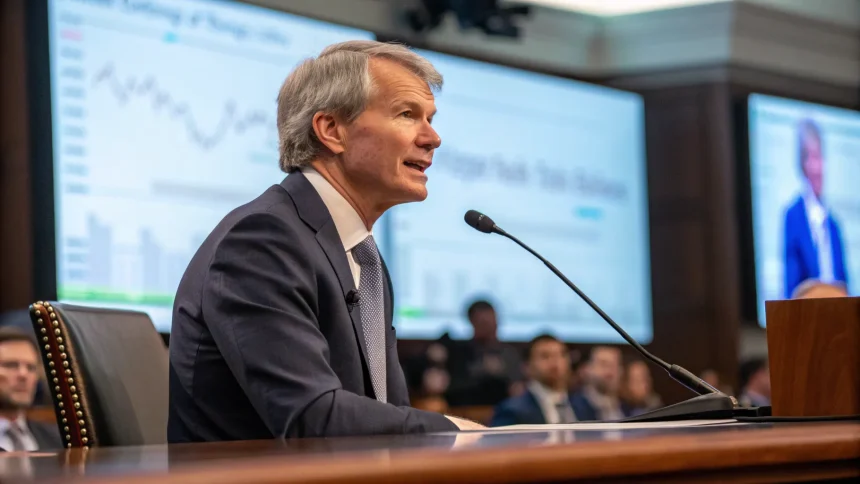Michael Saylor, the executive chairman and founder of MicroStrategy, argued that his company’s Bitcoin-first approach remains sound after the latest market slide, saying the business is built to endure. Speaking on the program Making Money, he framed the pullback as part of a long-running cycle and urged investors to focus on time horizons measured in years, not weeks.
The remarks arrive as crypto markets digest another retreat following a strong run earlier this year. Saylor positioned MicroStrategy’s strategy as resilient to short-term swings, while critics warn that concentrated bets on a single volatile asset can cut both ways. The debate highlights a broader question facing investors: how to treat Bitcoin’s sharp ups and downs within a diversified portfolio.
Why Saylor Says The Model Can Hold
Saylor has spent years turning MicroStrategy into a de facto Bitcoin operating company, combining enterprise software with a large digital asset treasury. He described the company’s framework as designed to weather turbulence, citing its equity base, long-dated financing, and multi-decade investment view.
Our business model is “pretty indestructible,” Saylor said, pointing to balance-sheet flexibility and long-term conviction.
MicroStrategy has repeatedly raised capital through equity offerings and convertible debt to acquire more Bitcoin. Supporters say that structure provides a cushion during downturns and leverage during rallies. The company has also pursued occasional profits from share price strength to bolster reserves.
Bitcoin’s History Of Sharp Swings
Bitcoin has a record of dramatic cycles that can challenge even experienced investors. Past drawdowns exceeded 50 percent in 2013–2014, 2018, and 2022, followed by rebounds that set new highs. That boom-bust pattern is central to both the bull case and the cautionary warnings.
Backers argue the asset’s fixed supply, combined with growing institutional access, supports a long-run uptrend despite steep corrections. Skeptics counter that macro shocks, regulatory actions, or liquidity strains can cut rallies short without warning.
- Past cycles featured deep pullbacks before recoveries.
- Liquidity and sentiment often drive short-term moves.
- Long horizons have historically reduced timing risk.
Investor Takeaways From The Pullback
On Making Money, Saylor framed the setback as an opportunity for investors who plan to hold through multiple cycles. His case rests on the idea that dollar-cost averaging and patience can smooth volatility. He also pointed to MicroStrategy’s operating revenue as a support that helps the company avoid forced selling during stress.
Advisers who take a more cautious stance say portfolio sizing matters more than conviction. Even bullish investors often cap exposure to single-digit percentages to prevent a drawdown from dominating overall returns. They recommend stress testing for scenarios where Bitcoin and risk assets fall together, a pattern seen in 2020 and 2022.
The Risk Debate Around Leverage
Much of the scrutiny focuses on MicroStrategy’s use of leverage. When prices rise, borrowed funds can magnify gains. When they fall hard, the same leverage increases losses and can trigger margin pressures. Saylor argues his firm has managed maturities and collateral to avoid forced sales during downturns.
Independent analysts note that long-dated debt and ample equity cushions reduce near-term risk, but they warn that prolonged weakness can still strain a leveraged balance sheet. For individual investors, the lesson is simple: understand how debt and derivatives can change the path of returns, not just the end result.
What Could Shape The Next Move
Several forces could influence Bitcoin’s direction in the months ahead. Liquidity conditions, interest rate expectations, and risk appetite remain key. Regulatory clarity and the growth of spot exchange-traded products could support steadier inflows, while adverse rulings or security incidents could sap demand.
Corporate adoption is another wildcard. If more companies follow MicroStrategy’s treasury playbook, market depth could improve. If boards shy away from volatility, the adoption curve may slow. Either outcome will feed the ongoing debate over whether Bitcoin behaves more like digital gold or a high-beta tech asset.
Saylor’s core message is unchanged: hold for the long run and use structure to survive the dips. The counterview is equally direct: sizing and risk controls matter most when the asset can drop by double digits in a week. For now, the pullback has revived a familiar test for crypto investors—balancing conviction with caution—and put fresh focus on how durable MicroStrategy’s strategy proves in the next phase of the cycle.







